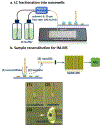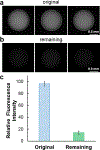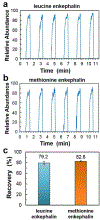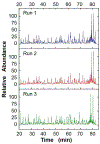Nanowell-mediated multidimensional separations combining nanoLC with SLIM IM-MS for rapid, high-peak-capacity proteomic analyses
- PMID: 30397757
- PMCID: PMC6500776
- DOI: 10.1007/s00216-018-1452-5
Nanowell-mediated multidimensional separations combining nanoLC with SLIM IM-MS for rapid, high-peak-capacity proteomic analyses
Abstract
Mass spectrometry (MS)-based analysis of complex biological samples is essential for biomedical research and clinical diagnostics. The separation prior to MS plays a key role in the overall analysis, with separations having larger peak capacities often leading to more identified species and improved confidence in those identifications. High-resolution ion mobility (IM) separations enabled by Structures for Lossless Ion Manipulation (SLIM) can provide extremely rapid, high-resolution separations and are well suited as a second dimension of separation following nanoscale liquid chromatography (nanoLC). However, existing sample handling approaches for offline coupling of separation modes require microliter-fraction volumes and are thus not well suited for analysis of trace biological samples. We have developed a novel nanowell-mediated fractionation system that enables nanoLC-separated samples to be efficiently preconcentrated and directly infused at nanoelectrospray flow rates for downstream analysis. When coupled with SLIM IM-MS, the platform enables rapid and high-peak-capacity multidimensional separations of small biological samples. In this study, peptides eluting from a 100 nL/min nanoLC separation were fractionated into ~ 60 nanowells on a microfluidic glass chip using an in-house-developed robotic system. The dried samples on the chip were individually reconstituted and ionized by nanoelectrospray for SLIM IM-MS analysis. Using model peptides for characterization of the nanowell platform, we found that at least 80% of the peptide components of the fractionated samples were recovered from the nanowells, providing up to ~tenfold preconcentration for SLIM IM-MS analysis. The combined LC-SLIM IM separation peak capacities exceeded 3600 with a measurement throughput that is similar to current one-dimensional (1D) LC-MS proteomic analyses. Graphical abstract A nanowell-mediated multidimensional separation platform that combines nanoLC with SLIM IM-MS enables rapid, high-peak-capacity proteomic analyses.
Keywords: Ion mobility; Mass spectrometry; Nanoelectrospray; nanoPOTS.
Conflict of interest statement
The authors declare no conflict of interests.
Figures





Similar articles
-
High-efficiency nanoscale liquid chromatography coupled on-line with mass spectrometry using nanoelectrospray ionization for proteomics.Anal Chem. 2002 Aug 15;74(16):4235-49. doi: 10.1021/ac0202280. Anal Chem. 2002. PMID: 12199598
-
Improved Sensitivity and Separations for Phosphopeptides using Online Liquid Chromotography Coupled with Structures for Lossless Ion Manipulations Ion Mobility-Mass Spectrometry.Anal Chem. 2018 Sep 18;90(18):10889-10896. doi: 10.1021/acs.analchem.8b02397. Epub 2018 Aug 29. Anal Chem. 2018. PMID: 30118596 Free PMC article.
-
Nanowell-mediated two-dimensional liquid chromatography enables deep proteome profiling of <1000 mammalian cells.Chem Sci. 2018 Jul 18;9(34):6944-6951. doi: 10.1039/c8sc02680g. eCollection 2018 Sep 14. Chem Sci. 2018. PMID: 30210768 Free PMC article.
-
[Applications of high performance liquid chromatography-mass spectrometry in proteomics].Se Pu. 2024 Jul;42(7):601-612. doi: 10.3724/SP.J.1123.2023.11006. Se Pu. 2024. PMID: 38966969 Free PMC article. Review. Chinese.
-
Advanced nanoscale separations and mass spectrometry for sensitive high-throughput proteomics.Expert Rev Proteomics. 2005 Jun;2(3):431-47. doi: 10.1586/14789450.2.3.431. Expert Rev Proteomics. 2005. PMID: 16000088 Review.
Cited by
-
The role of proteomics in assessing beta-cell dysfunction and death in type 1 diabetes.Expert Rev Proteomics. 2019 Jul;16(7):569-582. doi: 10.1080/14789450.2019.1634548. Epub 2019 Jun 24. Expert Rev Proteomics. 2019. PMID: 31232620 Free PMC article.
-
Single-cell Proteomics: Progress and Prospects.Mol Cell Proteomics. 2020 Nov;19(11):1739-1748. doi: 10.1074/mcp.R120.002234. Epub 2020 Aug 26. Mol Cell Proteomics. 2020. PMID: 32847821 Free PMC article. Review.
-
Fully Automated Sample Processing and Analysis Workflow for Low-Input Proteome Profiling.Anal Chem. 2021 Jan 26;93(3):1658-1666. doi: 10.1021/acs.analchem.0c04240. Epub 2020 Dec 22. Anal Chem. 2021. PMID: 33352054 Free PMC article.
-
Implementation of Ion Mobility Spectrometry-Based Separations in Structures for Lossless Ion Manipulations (SLIM).Methods Mol Biol. 2022;2394:453-469. doi: 10.1007/978-1-0716-1811-0_23. Methods Mol Biol. 2022. PMID: 35094340 Free PMC article.
-
Exploring new frontiers in type 1 diabetes through advanced mass-spectrometry-based molecular measurements.Trends Mol Med. 2024 Dec;30(12):1137-1151. doi: 10.1016/j.molmed.2024.07.009. Epub 2024 Aug 15. Trends Mol Med. 2024. PMID: 39152082 Review.
References
-
- Ong S-E, Mann M (2005) Mass spectrometry–based proteomics turns quantitative. Nat. Chem. Biol 1 (5):252–262 - PubMed
-
- Bantscheff M, Schirle M, Sweetman G, Rick J, Kuster B (2007) Quantitative mass spectrometry in proteomics: a critical review. Anal. Bioanal. Chem 389 (4):1017–1031 - PubMed
-
- Boschetti E, Righetti PG (2013) Low-abundance proteome discovery: state of the art and protocols. Elsevier, Oxford UK.
MeSH terms
Substances
Grants and funding
LinkOut - more resources
Full Text Sources
Research Materials

